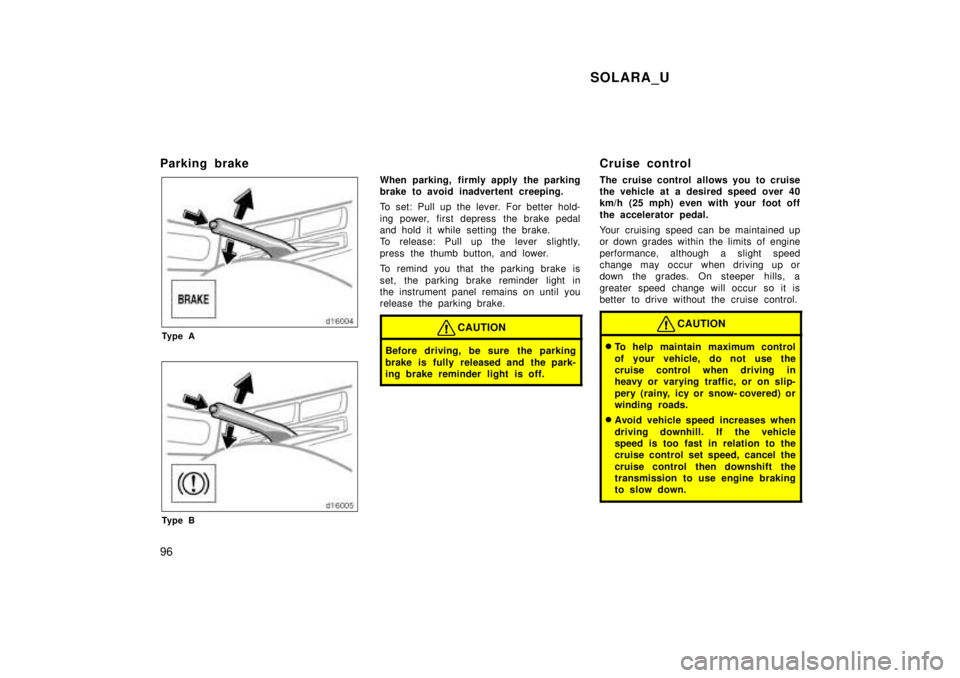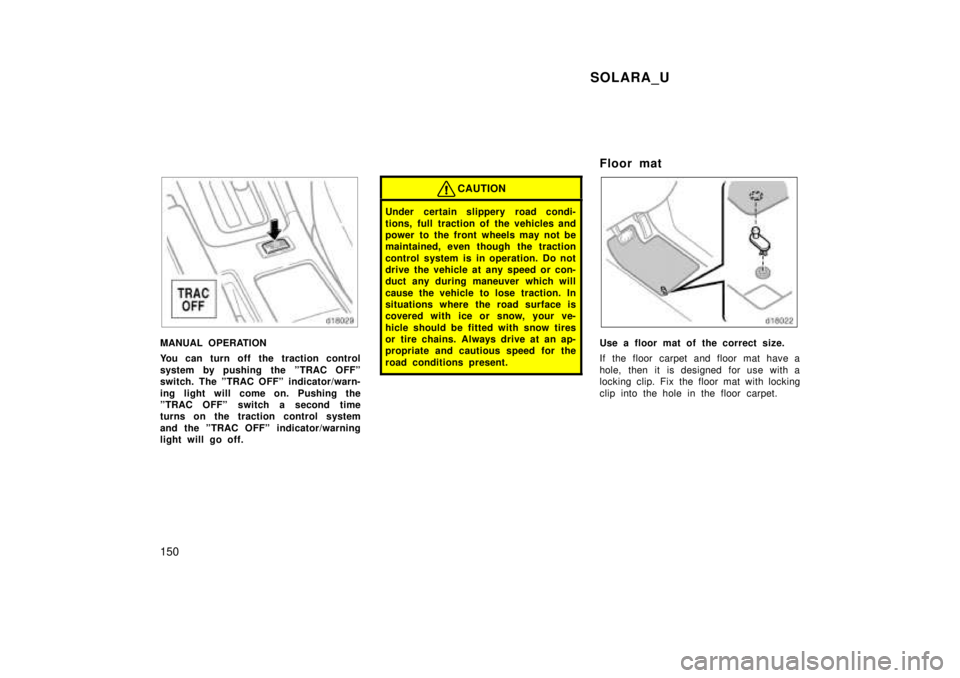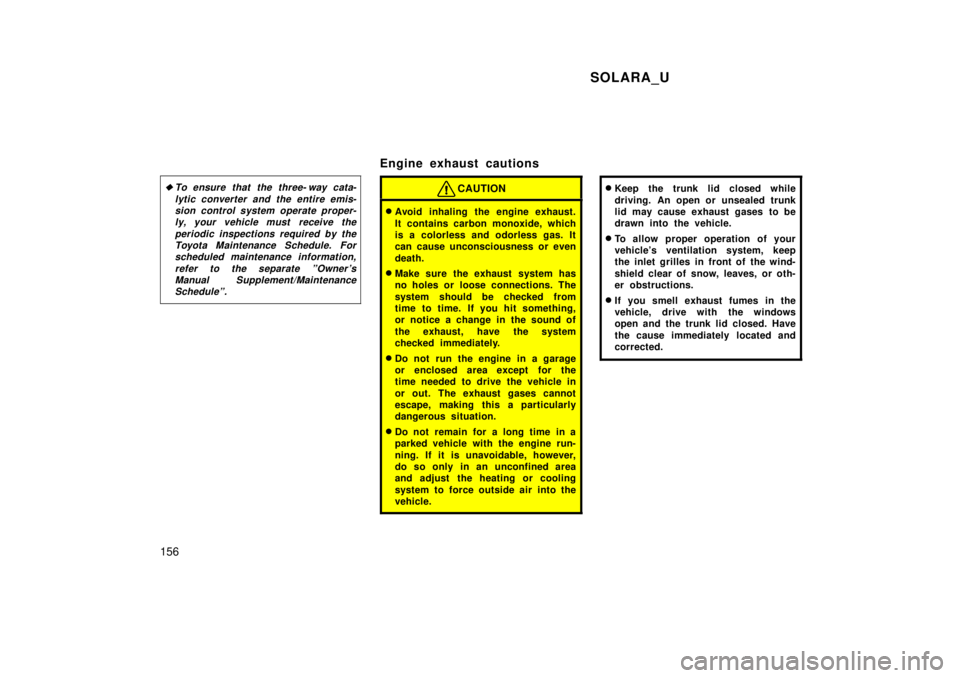1999 TOYOTA SOLARA MAINT
[x] Cancel search: MAINTPage 43 of 244

SOLARA_U43
The SRS (Supplemental Restraint Sys-
tem) airbags are designed to provide
further protection for the driver and
front passenger when added to the pri-
mary protection provided by the seat
belts.
In response to a severe frontal impact,
the SRS airbags work together with the
seat belts to help prevent or reduce injury
by inflating, in order to decrease the likeli-
hood of the driver 's or front passenger 's
head or chest directly hitting the steering
wheel or dashboard. The passenger airbag
is activated even with no passenger in the
front seat.
Be sure to wear your seat belt.
CAUTION
A driver or front passenger too close
to the steering wheel or dashboard
during airbag deployment can be
killed or seriously injured. Toyota
strongly recommends that: �The driver sit as far back as pos-
sible from the steering wheel while
still maintaining control of the ve-
hicle.
� The front passenger sit as far back
as possible from the dashboard.
� All vehicle occupants be properly
restrained using the available seat
belts.
This indicator comes on when the igni-
tion key is turned to the ºACCº or
ºONº position. It goes off after about
6 seconds. This means the SRS airbags
are operating properly.
The SRS airbag warning light system
monitors the airbag sensor assembly, in-
flators, warning light, interconnecting wir-
ing and power sources. (For details, see
ºService reminder indicators and warning
buzzersº in Chapter 1- 5.)
SRS driver and front
passenger airbags
Page 96 of 244

SOLARA_U
96
Parking brake
Ty p e A
Ty p e B
When parking, firmly apply the parking
brake to avoid inadvertent creeping.
To set: Pull up the lever. For better hold-
ing power, first depress the brake pedal
and hold it while setting the brake.
To release: Pull up the lever slightly,
press the thumb button, and lower.
To remind you that the parking brake is
set, the parking brake reminder light in
the instrument panel remains on until you
release the parking brake.
CAUTION
Before driving, be sure the parking
brake is fully released and the park-
ing brake reminder light is off.
Cruise control
The cruise control allows you to cruise
the vehicle at a desired speed over 40
km/h (25 mph) even with your foot off
the accelerator pedal.
Your cruising speed can be maintained up
or down grades within the limits of engine
performance, although a slight speed
change may occur when driving up or
down the grades. On steeper h
ills, a
greater speed change will occur so it is
better to drive without the cruise control.
CAUTION
� To help maintain maximum control
of your vehicle, do not use the
cruise control when driving in
heavy or varying traffic, or on slip-
pery (rainy, icy or snow- covered) or
winding roads.
� Avoid vehicle speed increases when
driving downhill. If the vehicle
speed is too fast in relation to the
cruise control set speed, cancel the
cruise control then downshift the
transmission to use engine braking
to slow down.
Page 150 of 244

SOLARA_U
150
MANUAL OPERATION
You can turn off the traction control
system by pushing the ºTRAC OFFº
switch. The ºTRAC OFFº indicator/warn-
ing light will come on. Pushing the
ºTRAC OFFº switch a second time
turns on the traction control system
and the ºTRAC OFFº indicator/warning
light will go off.
CAUTION
Under certain slippery road condi-
tions, full traction of the vehicles and
power to the front wheels may not be
maintained, even though the traction
control system is in operation. Do not
drive the vehicle at any speed or con-
duct any during maneuver which will
cause the vehicle to lose traction. In
situations where the road surface is
covered with ice or snow, your ve-
hicle should be fitted with snow tires
or tire chains. Always drive at an ap-
propriate and cautious speed for the
road conditions present.
Floor mat
Use a floor mat of the correct size.
If the floor carpet and floor mat have a
hole, then it is designed for use with a
locking clip. Fix the floor mat with locking
clip into the hole in the floor carpet.
Page 152 of 244

SOLARA_U
152
Part 2
INFORMATION
BEFORE DRIVING
YOUR TOYOTA �
Break- in period
�Fuel
�Operation in foreign countries
�Three- way catalytic converters
�Engine exhaust cautions
�Facts about engine oil
consumption
�
Twin ground electrode spark plugs
�
Brake system
�Brake pad wear limit indicators
�Luggage stowage precautions
�Your Toyota's identification
�Theft prevention labels
�Suspension and chassis
�Types of tires
Break- in period
Drive gently and avoid high speeds.
Your vehicle does not need an elaborate
break- in. But following a few simple tips
for the first 1600 km (1000 miles) can add
to the future economy and long life of
your vehicle: � Do not drive over 88 km/h (55 mph).
� Run the engine at moderate speed be-
tween 2000 and 4000 rpm.
� Avoid full- throttle starts.
� Try to avoid hard stops during the first
300 km (200 miles).
� Do not drive slowly with the manual
transmission in a high gear.
� Do not drive for a long time at any
single speed, either fast or slow.
� Do not tow a trailer during the first 800
km (500 miles). Fuel
FUEL TYPE
Your new vehicle must use only un-
leaded gasoline.
To help prevent gas station mix- ups, your
Toyota has a new smaller fuel tank open-
ing. The special nozzle on pumps with
unleaded fuel will fit it, but the larger
standard nozzle on pumps with leaded gas
will not.
At a minimum, the gasoline you use
should meet the specifications of ASTM
D4814 in the U.S.A. and CGSB 3.5- M93
in Canada.
NOTICE
Do not use leaded gasoline. Use of
leaded gasoline will cause the three-way catalytic converter to lose its ef-
fectiveness and the emission control
system to function improperly. Also,this can increase maintenance costs.
Page 156 of 244

SOLARA_U
156 �
To ensure that the three- way cata-
lytic converter and the entire emis-sion control system operate proper- ly, your vehicle must receive the
periodic inspections required by theToyota Maintenance Schedule. Forscheduled maintenance information,
refer to the separate ºOwner'sManual Supplement/Maintenance
Scheduleº.
Engine exhaust cautions
CAUTION
� Avoid inhaling the engine exhaust.
It contains carbon monoxide, which
is a colorless and odorless gas. It
can cause unconsciousness or even
death.
� Make sure the exhaust system has
no holes or loose connections. The
system should be checked from
time to time. If you hit something,
or notice a change in the sound of
the exhaust, have the system
checked immediately.
� Do not run the engine in a garage
or enclosed area except for the
time needed to drive the vehicle in
or out. The exhaust gases cannot
escape, making this a particularly
dangerous situation.
� Do not remain for a long time in a
parked vehicle with the engine run-
ning. If it is unavoidable, however,
do so only in an unconfined area
and adjust the heating or cooling
system to force outside air into the
vehicle.
�Keep the trunk lid closed while
driving. An open or unsealed trunk
lid may cause exhaust gases to be
drawn into the vehicle.
� To allow proper operation of your
vehicle's ventilation system, keep
the inlet grilles in front of the wind-
shield clear of snow, leaves, or oth-
er obstructions.
� If you smell exhaust fumes in the
vehicle, drive with the windows
open and the trunk lid closed. Have
the cause immediately located and
corrected.
Page 157 of 244

SOLARA_U157
FUNCTIONS OF ENGINE OIL
Engine oil has the primary functions of
lubricating and cooling the inside of the
engine, and plays a major role in main-
taining the engine in proper working order.
ENGINE OIL CONSUMPTION
It is normal that an engine should con-
sume some engine oil during normal
engine operation. The causes of oil
consumption in a normal engine are as
follows.
� Oil is used to lubricate pistons, piston
rings and cylinders. A thin film of oil
is left on the cylinder wall when a pis-
ton moves downwards in the cylinder.
High negative pressure generated when
the vehicle is decelerating sucks some
of this oil into the combustion chamber.
This oil as well as some part of the oil
film left on the cylinder wall is burned
by the high temperature combustion
gases during the combustion process. �
Oil is also used to lubricate the stems
of the intake valves. Some of this oil
is sucked into the combustion chamber
together with the intake air and is
burned along with the fuel. High tem-
perature exhaust gases also burn the
oil used to lubricate the exhaust valve
stems.
The amount of engine oil consumed de-
pends on the viscosity of the oil, the
quality of the oil and the conditions the
vehicle is driven under.
More oil is consumed by high- speed driv-
ing and frequent acceleration and decel-
eration.
A new engine consumes more oil, since
its pistons, piston rings and cylinder walls
have not become conditioned.
When judging the amount of oil con-
sumption, note that the oil may become
diluted and make it difficult to judge
the true level accurately.
As an example, if a vehicle is used for
repeated short trips, and consumes a nor-
mal amount of oil, the dipstick may not
show any drop in the oil level at all, even
after 1000 km (600 miles) or more. This
is because the oil is gradually becoming
diluted with fuel or moisture, making it
appear that the oil level has not changed. The diluting ingredients evaporate out
when the vehicle is then driven at high
speeds, as on an express way, making it
appear that oil is excessively consumed
after driving at high speeds.
IMPORTANCE OF ENGINE OIL LEVEL CHECK
One of the most important points in prop-
er vehicle maintenance is to keep the en-
gine oil at the optimum level so that oil
function will not be impaired. Therefore, it
is essential that the oil level be checked
regularly. Toyota recommends that the oil
level be checked every time you refuel
the vehicle.
NOTICE
Failure to check the oil level regularly
could lead to serious engine troubledue to insufficient oil.
For detailed information on oil level check,
see ºChecking the engine oil levelº in
Chapter 7- 2.
Facts about engine oil
consumption
Page 159 of 244

SOLARA_U159
You may hear a sound in the engine
compartment for a few seconds when the
engine is started or just after the vehicle
is started. This means that the anti- lock
brake system is in the self check mode,
and does not indicate a malfunction.
Effective way to press the ºABSº brake
pedal: When the anti- lock brake system
function is in action, you may feel the
brake pedal pulsating and hear a noise.
In this situation, to let the anti- lock
brake system work for you, just hold the
brake pedal down more firmly. Do not
pump the brake. This will result in re-
duced braking performance.
The brake pedal pulsation caused by the
anti- lock brake system may indicate haz-
ardous road surface conditions. Although
the anti- lock brake system assists in pro-
viding vehicle control, it is still important
to drive with all due care, because the
anti- lock brake system cannot overcome
the laws of physics that act on your ve-
hicle: � Braking capab ility is dependent on tire
friction with the road surface. �
Even though the anti- lock brake sys-
tem is operating, a driver cannot main-
tain full control on certain slippery road
surfaces, when cornering at high
speeds, or in violent maneuvers.
� Avoid high speeds on wet roads. The
anti- lock brake system cannot elimi-
nate the risk of hydroplaning and loss
of tire friction.
Always maintain a safe distance from the
vehicle in front of you. Compared with
vehicles not fitted with an anti- lock brake
system, your vehicle may r equire a longer
stopping distance in the following cases:
� Driving on rough, gravel or snow- cov-
ered roads.
� Driving with tire chains installed.
� Driving on roads where the road sur-
face is pitted or has other differences
in surface height.
Ty p e A
Ty p e B
Page 161 of 244

SOLARA_U161
Luggage stowage pr
ecautions
When stowing luggage or cargo in the
vehicle, observe the following: � Put luggage or cargo in the trunk when
at all possible. Be sure all items are
secured in place.
� Be careful to keep the vehicle bal-
anced. Locating the weight as far for-
ward as possible helps maintain bal-
ance.
� For better fuel economy, do not carry
unneeded weight.
CAUTION
�To prevent luggage or packages
from sliding forward during braking,
do not stack anything in the en-
larged trunk. Keep luggage or pack-
ages low, as close to the floor as
possible.
�Never allow anyone to ride in the
enlarged trunk. It is not designed
for passengers. They should ride in
their seats with their seat belts
properly fastened. Otherwise, they
are much more likely to suffer seri-
ous bodily injury, in the event of
sudden braking or a co llision.
� Do not place anything on the filler
panel behind the rear seatback.
Such items may be thrown about
and possibly injure people in the
vehicle during sudden braking or an
accident.
� Do not drive with objects left on
top of the instrument panel. They
may interfere with the driver's field
of view. Or they may move during
sharp vehicle acceleration or turn-
ing, and impair the driver's control
of the vehicle. In an accident they
may injure the vehicle occupants.
NOTICE
Do not load the vehicle beyond the
vehicle capacity weight specified inPart 8.
The vehicle identification number (VIN)
is the legal identifier for your vehicle.
This number is on the left top of the
instrument panel, and can be seen
through the windshield from outside.
This is the primary identification number
for your Toyota. It is used in registering
the ownership of your vehicle. Your Toyota's identificationÐ
ÐVehicle identification number